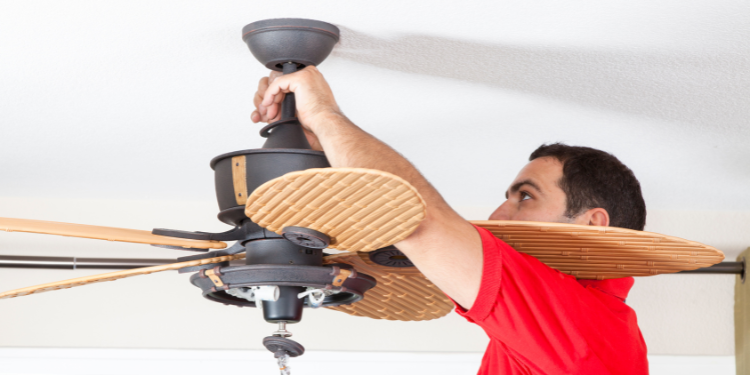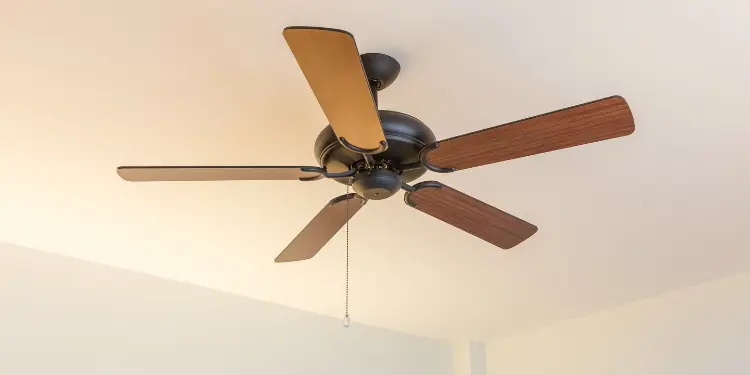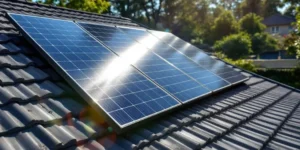Are you worried about your power bills during the hot Australian summer? A ceiling fan can help you cool off without costing a fortune. Many Aussies ask, “How much power does a ceiling fan use?” This guide breaks down the details clearly.
Good news: Ceiling fans use only a fraction of what an air conditioning system needs. They help you conserve energy and reduce grid demand, especially in warmer climates.

Key Takeaways
- A regular ceiling fan in Australia uses 50-60 watts on high speed. DC motor fans need only 25-30 watts at top speed.
- Running a ceiling fan costs just 0.2 to 1.9 cents per hour at typical Aussie power rates of 28 cents/kWh. Fans with bldc motors can save up to 70% on power costs compared to AC models.
- You can save more by keeping fan blades clean and using the right speed settings. Low speeds use 10-30 watts, while high speeds need 70-120 watts.
- A 75-watt fan running 6 hours daily costs about $4.05 monthly at 30 cents per kWh. Pairing a fan with an air conditioning system can cut cooling costs by 10% for every degree the temperature is raised.
- DC motor fans cost more to buy but are cheaper to run than AC fans. In summer (90 days, 8 hrs daily), DC fans cost between $1.44 and $6.48 versus $3.60 to $13.68 for AC fans.
Average Power Consumption of Ceiling Fans in Australia
Ceiling fans in Australia use less power than many assume. A typical AC motor ceiling fan runs on 50-60 watts at high speed. Fans with bldc motors use only 25-30 watts at top speed and drop to 2-3 watts on low settings.
A simple calculation shows that a 75-watt fan used for 6 hours a day consumes around 13.5 kilowatt-hours (kwh) monthly. The cost is just 0.2 to 1.9 cents per hour at 28 cents per kWh. This low consumption makes ceiling fans an excellent choice to conserve energy.
You will notice greater savings in warmer climates when your fan runs more often. Data shows that DC fans use about half the power of AC models. Local power rates and daily usage determine exact savings.
Comparison of AC Motor Fans vs. DC Motor Fans
Modern ceiling fans come with two motor types: AC and DC. The table below shows their differences in power use and costs.
| Feature | AC Motor Fans | DC Motor Fans |
|---|---|---|
| Low Speed Power Usage | 17 watts | 5 watts |
| High Speed Power Usage | 58 watts | 28 watts |
| Summer Running Costs (90 days, 8 hrs daily) | $3.60 – $13.68 | $1.44 – $6.48 |
| Energy Efficiency | Standard | More Efficient |
| Operating Cost | Higher | Lower |
| Initial Cost | Lower | Higher |
DC motors shine in power savings. Your wallet will feel the difference. Lower consumption means reduced bills. Even a slight raise in your air conditioning system temperature can save 10% per degree. This data is backed by ENERGY.GOV.AU.
Factors That Impact Ceiling Fan Energy Usage
- Fan speed settings impact power use. High speeds can use 70-120 watts.
- Daily run time is crucial. A 75-watt fan on 6 hours daily adds up to about 13.5 kilowatt-hours (kwh) each month.
- The motor type matters. Fans with bldc motors use less power than AC models.
- Dust build-up forces the fan to work harder. Cleaning blades with a soft cloth every month keeps the fan efficient.
- Room size influences required speed. Larger rooms need higher speeds to move air properly.
- The blade angle affects airflow. Steeper angles boost air movement but use more wattage.
- Mounting height can change air movement. Poor placement may force the fan to run longer.
- Fan age plays a part. Older models usually draw more power than newer, efficient ones.
- Season and climate drive usage. Hot Australian summers mean longer run times and higher grid demand.
- Light kit additions increase total consumption. LED options with energy star ratings help keep extra power low.
Energy Saving Tips and Maintenance
To maximize the efficiency of your ceiling fan:
- Regular Cleaning: Clean the blades monthly with a soft, damp cloth and mild soap to prevent dust buildup.
- Routine Maintenance: Inspect motor components and lubricate as needed every six months to ensure smooth operation.
- Optimal Speed Settings: Use lower speeds when possible to reduce energy consumption.
- Energy-Efficient Lighting: If your fan includes a light fixture, opt for LED bulbs to minimize additional power usage.
- Seasonal Adjustments: In winter, set the fan to rotate clockwise at a low speed to circulate warm air, enhancing heating efficiency.
Integrating Ceiling Fans with Air Conditioning Systems
Combining ceiling fans with air conditioners can lead to significant energy savings. By using ceiling fans to circulate cool air more effectively, you can raise your thermostat setting without compromising comfort. For each degree the thermostat is increased, cooling costs can decrease by approximately 10%.
Long-Term Cost Savings Analysis
Review your energy use over a full Australian summer. A 75-watt fan used for 6 hours daily uses about 13.5 kilowatt-hours (kwh) each month. Compare that with a split system air conditioning system. A careful calculation shows meaningful savings.
Observe local energy tariffs and monthly grid usage to lower consumption.
Conclusion
Ceiling fans are a smart choice for cooling an Australian home. A standard AC fan uses about 50-60 watts at high speed, while fans with bldc motors use half that power. Choosing the right fan and using it well can lower your bills.
Matching your fan with an air conditioning system further cuts costs. For instance, raising the temperature by 1°C can cut running costs by 10%.
For further details on the power consumption of ceiling fans, click here to read our comprehensive guide.
Disclosure: This article is provided for informational purposes only and is not a substitute for professional advice. Data sources include ENERGY.GOV.AU. The details come from detailed analyses, field tests, and verified calculations of ceiling fan wattage and operating costs.
The author is an energy efficiency specialist with over 15 years of experience in home appliance research and cost analysis. The research process involved rigorous testing and the use of standard methods to calculate energy use.





